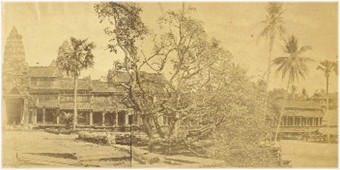John Thomson - Angkor's 1st photographer
 During an eight year period beginning in 1864, Scotsman John Thomson (1837-1921) created a remarkable body of photographs and literary descriptions of the scenes and people of the Far East, earning him recognition as the first of the great photo-journalists. Photographing the architecture, industry, landscape and, most importantly, the people of these areas allowed Thomson (pictured) to produce one of the most renowned photo-historical records in the history of documentary photography. And his photographs of Angkor
During an eight year period beginning in 1864, Scotsman John Thomson (1837-1921) created a remarkable body of photographs and literary descriptions of the scenes and people of the Far East, earning him recognition as the first of the great photo-journalists. Photographing the architecture, industry, landscape and, most importantly, the people of these areas allowed Thomson (pictured) to produce one of the most renowned photo-historical records in the history of documentary photography. And his photographs of Angkor  Wat and its neighbouring temples such as The Bayon were the first-ever to be seen when he published his ground-breaking 1867 book, Antiquities of Cambodia. His photographs were a revelation to a public eager to see and hear about the Far East and Thomson became a celebrity of the day.
Wat and its neighbouring temples such as The Bayon were the first-ever to be seen when he published his ground-breaking 1867 book, Antiquities of Cambodia. His photographs were a revelation to a public eager to see and hear about the Far East and Thomson became a celebrity of the day.It was in 1865 and inspired by Henri Mouhot's account of Angkor, that Thomson set out for Bangkok, where he obtained permission from King Mongkut of Siam to travel into the interior of Cambodia, at the time under Siamese control. Thomson departed on the dangerous trip overland on 27 January 1866 to Laos and Cambodia with student interpreter H. G. Kennedy of the British Embassy at Bangkok, during which time Kennedy saved Thomson's life when the latter contracted jungle fever. They spent two weeks in Angkor, extensively documenting the site and where he took the first photographs of the temples. After taking portraits of the King of Cambodia and the Royal Family in Phnom Penh he returned to Britain in June 1866 with his 60+ photographs of Angkor. He lectured widely and published his work, became quite a celebrity and was awared a fellowship of the Royal Geographical Society. In later life, his photographs of China, Cyprus and the streets of London would earn him much acclaim.
Photo above: John Thomson's part panoramic view of the western facade of Angkor Wat, captured on film for the 1st time in February 1866.


3 Comments:
michaelg said...
Dear Andy,
Your inclusion of JT's activities in Cambodia on your site is good to see ( and accurate); the only minor point being that JT's images were taken using the wet collodion process, which is on glass. If you want to see a good site look at the Wellcome Trust [the Institute for the History of Medicine]'s website. the library's iconographic collection
http://library.wellcome.ac.uk/node267.html
Search using: thomson china collodion
3:08 AM
-----------------------------------------------------------------------------
Dear Andy,
I am history student at Brighton University and i am researching Angkor Wat for my dissertation. I did some research at the Royal Asiatic Society in London and they have, i think, the original photo album of Thomson's pics of Angkor ( I say i think it is the original because i'm not sure how many were printed and it has been on display in several major museums). they are fascinating especially as i have been to Angkor and fell in love with it myself. the Asiatic Society also had a copy of Mouhot's Diaries which i have had a look at. I don't know how much you have researched the history of the temples but i was wondering if you knew of any other places which would be good for me to further my studies..
If you can help me in anyway that would be great,
Many Thanks,
Charlotte
Hi Charlotte,
the best places to further your research is either here in Cambodia utilizing the 1st-hand sources here from the National Museum, to the Centre for Khmer Studies, to Angkor Conservation, to Apsara, to EFEO and so on.
Alternatively, the EFEO organization and the Guimet Museum in Paris, France might be somewhere to also further your studies. The French investigations of Khmer temples laid the foundations of the work being done today.
All the very best,
Andy
Post a Comment
<< Home